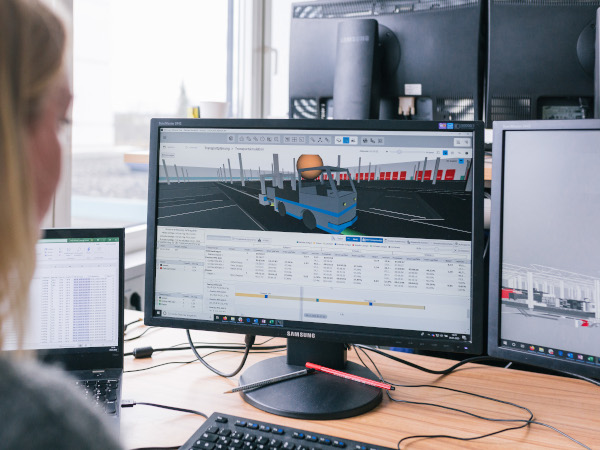Time to read: 5 min
Intralogistics (planning and optimization)
- Optimization of the internal material flow

What is intralogistics?
Intralogistics or internal logistics comprises the flow of materials, information and goods within a factory. It is differentiated from external logistics, which involves the transport of goods outside a company. Intralogistics covers all processes and areas within the factory:
- Incoming goods, outgoing goods
- Transport systems
- Warehouse (storage systems, warehouse planning, warehouse management, shelves)
- Order picking or picking zones
- Production, assembly
What is intralogistics planning?
In the context of intralogistics planning, internal processes should be optimally interconnected. All processes (material flow, storage, information flows and production processes) ideally run together perfectly.Why is it important to plan and optimize intralogistics?
Companies face many challenges. Smooth operations in intralogistics is one of them.
-
Bottlenecks
Increasing variant diversity often leads to bottlenecks in the different areas of a factory. Good intralogistics planning ensures that bottlenecks are reduced and material flows are optimized.
-
Lack of transparency
The increasing complexity of factory systems and flows of goods leads to unclear processes. A holistic integration is missing. Optimal logistics planning is now a time-consuming & complex task for the planner.
-
Time pressure
Internal processes (logistics planning) are not optimally coordinated. This results in waiting times and unnecessary breaks.
-
Rising costs
Elaborate warehouse technology, storage systems & conveyor technology lead to increasing costs.
Are you not yet planning your standard intralogistics processes? Unsure where to begin? We can help!
How are intalogistics processes planned and optimized?
The path to holistic and sustainable intralogistics is not far! Interconnected intralogistics and material flow planning can be achieved in just a few steps.
-
1. Record current status
record and bundle resources, processes, times, shift schedules, parts data, production data, Excel sheets
-
2. Layout planning
creation of a factory layout
-
3. Modeling of material flows
flow of goods is displayed
-
4. Resource requirements
The resource requirements are determined: Personnel, transport systems (driverless transport systems, tugger trains, forklifts, …), racking systems.
-
5. Cost calculations
In the last step, a cost and personnel evaluation can be determined.
In the following webinar, we will show you what intralogistics planning and optimization can look like.
Plan and optimize intralogistics: software helps!
-
Automated transportation planning
Evaluation of resource requirements and employee requirements (dynamic): tugger train requirements, employee requirements, tours per day, total distance and process times. -
Quick rescheduling
Rescheduling possible at the push of a button without having to change countless documents. -
3D simulation and visualization
Visualization puts an end to unpleasant surprises because an Excel formula was copied incorrectly. A 2D representation of the material flow by e.g. Sankey diagram and heatmap also helps to optimize the material flow. -
Line back calculation
Resource planning is based on the production program. -
Automatisierte Auswertung
Evaluation of resource requirements and employee requirements (dynamic): tugger train requirements, employee requirements, tours per day, total distance and process times.
Die Basis für einen reibungslosen Produktionsprozess ist das Vorhandensein aller notwendigen Kapazitäten. Fehlen benötigte Sachressourcen und Personalressourcen, stockt die Fertigung. Gerade bei... Your company should actually be able to operate as efficiently as possible. Deploying your employees ideally in complex situations can be a challenge and a real Sisyphean task. The optimal... The provision of materials in assembly and production is an increasingly important topic for many companies. The constantly expanding variety of products and product variants often leads to...Resource Planning Software
Simply and Effectively Create a Shift Plan for Assembly with ipolog Software
Material Supply Planning Software

